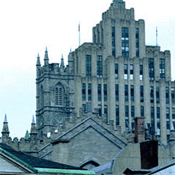webwork 2
where are you?
by Olga KISSELEVA (Russia/France), 2003
 Project produced by Groupe Molior (Montréal) and La Chambre Blanche (Québec).
Project produced by Groupe Molior (Montréal) and La Chambre Blanche (Québec).
In her work titled Where Are You?, Olga Kisseleva challenges us to a veritable whodunit. We are presented an image representing one of forty cities the artist took photos of around the world, and we have 15 seconds to try to identify the city from such hints as monuments that we may recognize, the aspect of a street, sometimes the look of the people, and then to click on what seems the right city. More often than not, we make a mistake and a message pops up to shame our deductive talents - "Wrong city!" We can always try our luck another time by reloading the page. After a few frustrated tries, we wind up clicking randomly, and then systematically through all the names before eventually, and inevitably, falling on the right answer. Again, more often than not, the right answer surprises us. The moral of the tale: "Maybe you are never where you think you are."
For, in the end, how do we recognize a city? There's what one can see of it, how one lives it, how one imagines or dreads it - all this combines, of course, in one's experience of the city.
A city is thus above all an image, a face, memories - of readings, films, pictures, trips, encounters, chances - that we associate with it. All too often, a city is also a cliché: the Eiffel Tower of Paris, city of light, the skyscrapers of New York, symbol of the American way of life (the 9/11 terrorists got that right), the antiquity of Cairo, the faded glory of ancient Egypt and the current Third World. A city is thus more than an architectural assemblage of stone and concrete: a city is (first) the idea we have of it. In this sense, the cite has always been virtual - which, of course, is one of the reasons cyberspace has so readily and spontaneously been compared to a city. For the city, prime venue for meetings and exchanges, locus of history, of stories true and possible, has deep roots in the past, and looks forward to the future it anticipates; it, too, is permanent and fleeting at once. Architectural influences, ways of life, fashion, have certainly not waited for the modern era to spread, mix, and combine. Of course these exchanges have proliferated and sped up with industrialization, and in our contemporary era, globalization. Should we speak of evolution, or decry homogenization? There are buildings in Cairo, Gothic churches in New York: does that mean these cities have lost character, that is, their individuality, their identity?
It isn't so simple. Too often, the idea one has of the city is misleading - simply because it's too simplistic. For every city, there's the city of its residents, the city of the tourists, of historians, of urban planners, of promoters or activists, of the poor, of the rich, of the excluded. The city as such, in the end, is always in motion, in suspense between harmony and discord, the outcome of conflict and exchange, real and idealized at once. Kisseleva's work raises all these questions, lightheartedly, humorously, in the interactive and fleeting game that only the Web can offer.
Anne-Marie Boisvert
(Translated from French by Ron Ross)

 top top
 back back
|
